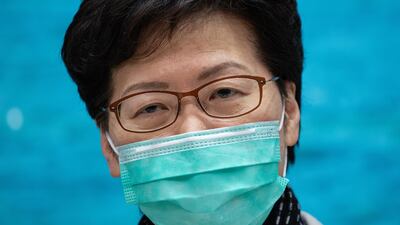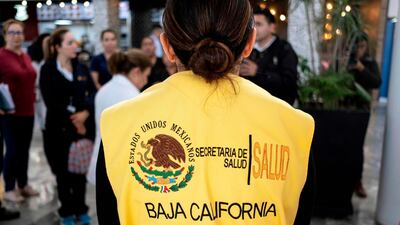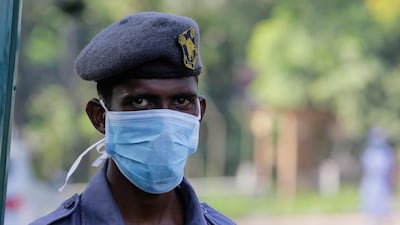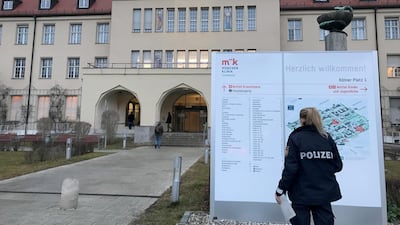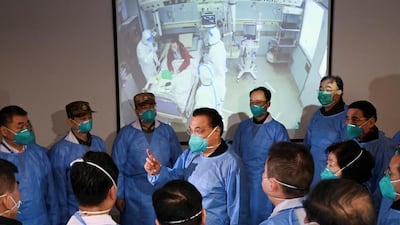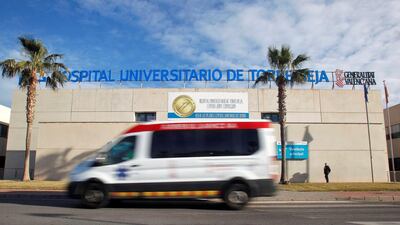On New Year’s Eve 2019 at 10.00am EST, an artificial intelligence company in Toronto, Canada sent out a communication about more than 20 reported cases of a severe respiratory syndrome in Wuhan, China associated with the Wuhan South China Seafood Market “with no cause yet identified”.
The notification landed in the inboxes of healthcare workers in Canada and the US, as well as clients in South-East Asia and some airlines, about a week before public warnings from the UN World Health Organisation about a novel coronavirus that had been identified in the massive capital of central China’s Hubei province.
"We didn't know it was going to turn into a global outbreak," Dr Kamran Khan, an infectious disease physician and founder and chief executive of BlueDot, told The National.
His company, made up of a team of about 40 physicians, veterinarians, epidemiologists, statisticians and computer scientists, determined that what they were seeing from the data they gathered on December 31 looked a lot like the origins of Severe Acute Respiratory Syndrome (Sars) in 2002: a new pneumonia-like virus linked to an animal market in China.
How did they know that? By listening.
BlueDot uses machine learning and natural language processing methods (two subsets of AI) to monitor about 100,000 websites in 65 different languages from all over the world. The AI algorithms are trained to pick up chatter on infectious diseases from official local news channels, physicians' public web forums and government and NGO communications. BlueDot scans for this information every 15 minutes, 24 hours a day, every day of the year.
Infectious diseases pose a growing threat in an increasingly interconnected world as booming global travel, urbanisation and climate change make cases more frequent and severe.
The company, founded in 2013 and with nearly $10 million (Dh36.7m) in venture capital to date, is part of a new breed of public health response that relies on technology and open-source information to inform front-line responders and help them heal patients.
BlueDot is helping its clients like public health workers and airlines “anticipate rather than react”, according to Dr Khan. He recalled that St Michael’s Hospital in Toronto, where he still works, “didn’t really know what Sars was until it showed up” in 2003. The outbreak “crippled the city” for four months, and killed 44 people there.
Since BlueDot first picked up on the emerging coronavirus, China has sealed off millions of people near the centre of the outbreak in an unprecedented quarantine effort as the death toll climbed to more than 100 and the number of confirmed cases jumped to almost 6,000 by Wednesday.
The UAE recorded its first confirmed case of the virus on Wednesday.
Part of BlueDot's work is predicting where outbreaks are likely to go internationally by looking at commercial air-traffic data.
Since most outbreaks happen halfway around the world, BlueDot assesses “if there is a sufficiently large amount of people coming to your backyard, in the 'pathway of the epidemic’, we would notify you that that is something you should pay attention to”, Dr Khan said.
In the days after the Wuhan coronavirus emerged but before the mandatory quarantine issued by Chinese authorities, BlueDot accurately said that the virus would travel from Wuhan to Bangkok, Seoul, Taipei and Tokyo, based on air-travel patterns from the Chinese province. They published their findings and a list of 20 destinations receiving the most passenger traffic from Wuhan, alongside a readiness score for a given city to cope with an outbreak, in the Journal of Travel Medicine.
Sydney and Victoria in Australia, and Dubai, were the only three destinations in the top 20 that are outside of East Asia, but every country on the list that received high volumes of passenger traffic from Wuhan had high readiness scores, “corresponding to relatively strong public health and healthcare capacity,” they found.
“The UAE has grown a lot in the last 15 years and is a very important traffic hub,” Dr Khan said. “Places that have that level of inter-connectedness are places that it’s pertinent to have these kinds of insights to understand these kinds of threats.”
The challenge is to not overwhelm healthcare workers or front-line responders with a deluge of information.
Location-specific insights are vital, according to Dr Khan. “So that a person in Dubai versus Singapore versus London is getting different information that is relevant to them and how they are connected to any outbreak.”
John Oxford, emeritus professor of virology at the University of London and co-author of the textbook Human Virology, told The National on Sunday: "I think it could reach that [level of Sars], but not more," he said. "With all this attention and quarantine, and we have the experience of Sars so we know the public health measures – quarantine, social distance, hand washing – that should knock it on the head."
Dr Khan is putting his faith in healthcare workers as "the rubber hits the road in emergency departments”. Although most clinicians only receive a day or two of tropical medicine training in school, their access to information as it is occurring day to day has never been better. BlueDot is helping them to “think global but act local”. But they have their work cut out.
“It is an easy adage and far more difficult to operationalise,” Dr Khan said.
But progress, he feels, is certain.
“When Sars was happening in Toronto back in 2003 I had my first BlackBerry. We've come a long way."
